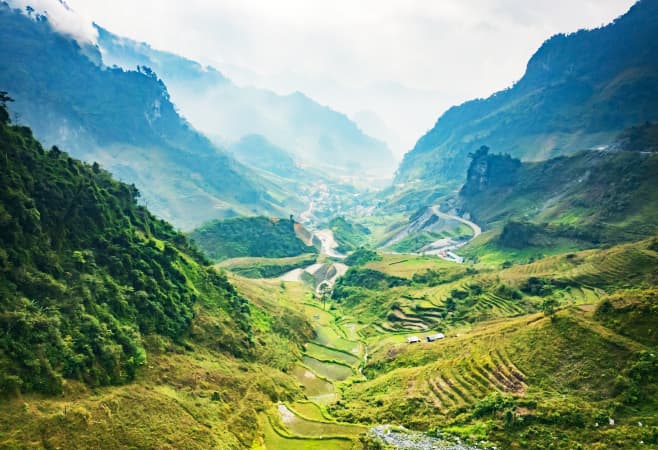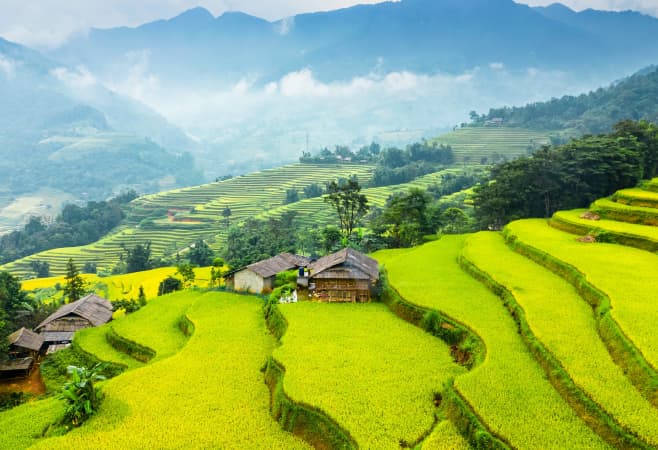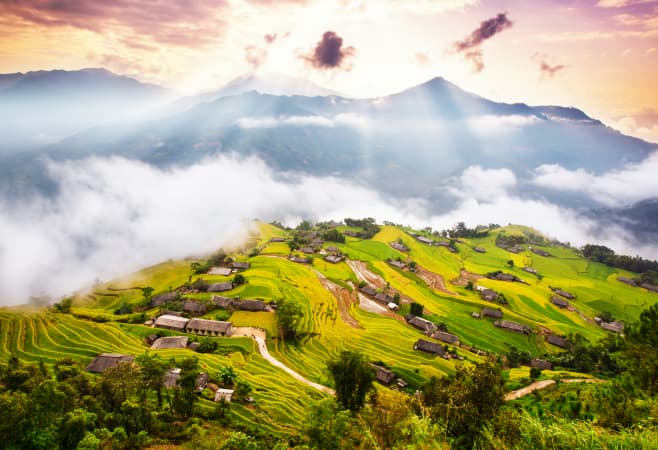Ha Giang in Vietnam: Breathtaking loops & nature’s majesty
The remote northern region of Vietnam keeps Ha Giang province as one of the few remaining unspoiled regions along with its ethnic diversity. Raw adventure defines Ha Giang because it stands apart from the commercialized cities and overtouristed highlands of Sapa. The region features limestone peaks which rise above the clouds and age-old cultures live protected from contemporary turmoil while narrow, winding roads provide access to Southeast Asia's most breathtaking views.
The region of Ha Giang distinguishes itself through its unique double character. The region functions as an active museum of Vietnam's cultural heritage alongside an enduring representation of its strong natural forces. Visitors to Ha Giang are both challenged and rewarded, as the region offers profound cultural and natural experiences
Throughout its history Ha Giang operated as a vital border territory because of the prolonged trading and military tensions with China across its frontier. Today, the province stands as a symbol of national unity, welcoming adventurers, historians, and cultural enthusiasts alike.
- Geography and location
- Weather and best time to visit
- Getting to Ha Giang
- Cultural tapestry of Ha Giang
- Ha Giang Loop – The iconic journey
- Local cuisine and street food
- Hiking and trekking trails in Ha Giang
- Accommodations in Ha Giang
- Festivals and celebrations
- Ha Giang historic house and cultural landmarks
- Comparing Ha Giang to Sapa
- Conclusion: Ha Giang in Vietnam

Ha Giang aerial landscape in Northern Vietnam
Geography and location
The northernmost region of Vietnam positions Ha Giang beyond 300 kilometers from Hanoi while it shares an uneasy border with Yunnan province in China. The province displays a mountainous terrain with karst formations and verdant valleys and winding rivers as its main geographical features.
Its topography is not just scenic - it’s symbolic. The secrets of Ha Giang province expose themselves at every bend of its roads. The Dong Van Karst Plateau Geopark serves as a UNESCO-recognized wonder with towering limestone cliffs known as karsts that stand out prominently across the area. The landscape includes small hamlets situated below rice terraces that link through dangerous mountain paths that seem to defy natural laws of balance.
The region transitions from heavy forests into bamboo forests and concealed waterfall sites as one travels toward the west. The eastern parts of Ha Giang present cooler temperatures and heavier rainfall together with a stunning diversity of species.
Weather and best time to visit
Visiting Ha Giang requires careful planning regarding the timing because it determines how much you can enjoy the destination. The highland location of Ha Giang causes seasonal changes that result in four distinct weather patterns.
| Season | Weather | What to Expect |
| Spring (Mar–May) | Cool and mild | Blooming flowers and rice field preparation |
| Summer (Jun–Aug) | Warm with rain | Lush greenery, heavier rainfalls |
| Autumn (Sep–Nov) | Clear and dry | Ideal for photography and biking |
| Winter (Dec–Feb) | Cold, foggy | Misty landscapes and festivals |
Best Months: October and November offer crisp air and clear skies - perfect for the Ha Giang Loop. Spring is also magical when peach and plum blossoms paint the region in color.
Getting to Ha Giang
Reaching Ha Giang in Vietnam is an adventure in itself. Tucked away from the usual tourist routes, the journey to Ha Giang tests your travel mettle - but rewards you tenfold. Most travelers begin their trip in Hanoi, Vietnam’s capital, which serves as the gateway to this remote northern province.
From Hanoi to Ha Giang:
- By bus: Overnight sleeper buses run daily from Hanoi’s My Dinh Bus Station. The trip takes around 6-8 hours and usually costs between $10 to $20 USD.
- By motorbike: Adventurous travelers often ride up from Hanoi. It’s a long journey (approximately 300 km), but the changing landscapes along the way make it unforgettable.
- By private car or tour: If you prefer comfort and a guide, numerous travel agencies offer private transfers or full tour packages from Hanoi.
Tips for the Road:
- Travel at night to save time; most sleeper buses offer decent comfort.
- If you're riding a motorbike, check road conditions ahead - especially during the rainy season.
- Carry some Vietnamese Dong, as ATMs become rare once you’re past the town of Ha Giang.
Cultural tapestry of Ha Giang
Travelers who enjoy exploring different cultures will find absolute pleasure in visiting Ha Giang in Vietnam. The province contains more than twenty ethnic minority groups which maintain unique customs and languages and traditional clothing styles and traditional celebrations. Five main groups dominate the ethnic population of Ha Giang province including the Hmong, Tay, Dao, Nung and Lo Lo.
- Traditional clothing: Ethnic women often wear handmade, embroidered costumes with stunning patterns that change by region.
- Markets as cultural hubs: Weekly markets in Meo Vac and Dong Van function as cultural hubs beyond their commercial purpose since they serve as social meeting places where both new relationships and dispute resolutions occur along with the transfer of traditional knowledge.
- Customs and ceremonies: From Hmong funerals to Dao New Year rituals, the cultural richness here is profound and respectfully preserved.
The complete experience of this region can be achieved by staying with local families who will share both traditional eating customs and neighborhood insights. The authentic encounters with local people transform Ha Giang into something beyond its natural beauty.
Ha Giang Loop – The iconic journey
The Ha Giang Loop stands as the top attraction for visitors to Ha Giang because this circular path allows riders to experience Vietnam's most breathtaking natural wonders. The 350-kilometer route passes through mountain passes along with narrow canyons between deep valleys and ethnic minority villages.
| Day | Destination | Highlights |
| Day 1 | Ha Giang → Quan Ba | Heaven’s Gate, Twin Mountains |
| Day 2 | Quan Ba → Dong Van | Karst plateaus, Hmong villages |
| Day 3 | Dong Van → Meo Vac | Ma Pi Leng Pass, Nho Que River |
| Day 4 | Meo Vac → Ha Giang | Riverside ride, relaxed return |
Tips for the Loop:
- Rent your bike from reputable shops like QT Motorbikes in Ha Giang city.
- Carry a valid International Driving Permit (IDP) - Vietnam enforces this.
- Prepare for steep climbs and winding descents. Confidence is key!
For non-riders, don’t worry - many tour operators offer chauffeured motorbike or jeep tours, so you can enjoy the ride without the risk.

Ma Pi Leng Pass and Nho Que River, Meo Vac, Dong Van, Ha Giang, Viet Nam
Dong Van karst plateau geopark
The UNESCO Global Geopark stands as the most precious possession in Ha Giang province. The Dong Van karst plateau extends across 2,300 square kilometers while presenting Southeast Asia's oldest rock formations that have existed since 400 million years ago. The area presents visitors with fascinating jagged limestone peaks which stand beside deep gorges alongside rich fossil deposits.
- Geological Diversity: It's not just rocks - this area hosts breathtaking vistas that shift with every bend in the road.
- Ethnic Culture: The plateau is also a living museum of minority traditions.
- Accessibility: Well-paved roads and clear signages make self-exploration possible for intrepid travelers.
Be sure to hike to Lung Cu Flag Tower, Vietnam’s northernmost point, offering panoramic views into China. It’s both a geographical and symbolic milestone of Vietnamese pride.

Lung Cu Flag Tower
The Ma Pi Leng pass experience
Ask any traveler about their favorite memory from Ha Giang and the Ma Pi Leng Pass almost always tops the list. Often dubbed the most dangerous and most beautiful road in Vietnam, this serpentine mountain pass offers surreal views over the emerald Nho Que River and surrounding cliffs.
- The scenery is simply otherworldly - think sharp mountain ridges plunging into jade-colored waters.
- Sunrise and sunset here are spiritual moments - photographers, get ready.
- You can rent a boat at Tu San Canyon for a peaceful river ride through sheer cliffs.
It’s a white-knuckle ride for sure, so drive slow, pull over often and enjoy the grandeur of nature.
Must-visit towns and villages
Each village and town in Ha Giang reveals a different slice of life:
- Dong Van Old Quarter: With its stone houses and colorful weekend market, it’s a fantastic blend of culture and history.
- Meo Vac: Quiet and traditional, yet it bursts into life every Sunday with its market.
- Yen Minh: Known as the 'pine city' of the North, it offers serene homestays and forested hills.
- Lung Cu Village: Home to the Lo Lo ethnic group and Vietnam’s northernmost landmark.
Traveler Tip: Don’t just pass through - spend at least a night in a remote village. That’s where the real stories unfold.
Local cuisine and street food
A trip to Ha Giang in Vietnam wouldn’t be complete without indulging in its hearty and flavorful cuisine. Influenced by the region’s altitude, ingredients are often preserved or foraged - giving dishes a unique taste of the wild.
- Thang Co: A traditional horse meat stew, best enjoyed at local markets.
- Au Tau Porridge: Made with a mildly toxic root (carefully prepared) and pork, it’s warm and nourishing.
- Five-color sticky rice (Xoi Ngu Sac): A vibrant mix that’s both artistic and tasty.
Visit the Meo Vac Night Market for grilled skewers, sticky rice cakes and hot corn wine that’ll warm you up after a chilly mountain day.
Hiking and trekking trails in Ha Giang
For nature-loving tourists, embarking on a Ha Giang trek is an absolute must. This northern frontier is a haven for hikers, offering pristine trails, untouched ridges and immersive experiences that bring you closer to Vietnam’s heart and heritage.
- Hoang Su Phi Terraced Fields: Best visited in the rice harvest season (September–October), this area provides breathtaking treks through layered rice terraces and traditional Dao villages.
- Lung Cu to Pho Bang: A rugged trail that winds past border villages, it’s ideal for those seeking a combination of cultural exposure and physical challenge.
- Trekking in Dong Van Plateau: Offering surreal geology and panoramic vistas, this is where the phrase "Ha Giang adventure" comes to life.
Whether you join a guided group or go solo, trekking in Vietnam Ha Giang is as rewarding as it is humbling. The slow pace allows you to appreciate the stunning scenery and the warm hospitality of the locals.

Beautiful landscape in Hoang Su Phi, Ha Giang, Vietnam
Motorbiking tips for Ha Giang loop
The Ha Giang Loop is arguably the most iconic motorbike journey in Vietnam and for good reason. With cliffside roads and exhilarating switchbacks, it’s the ultimate Ha Giang road trip.
- Rent from Jasmine Ha Giang: Highly rated, this rental agency provides reliable bikes and safety gear. They also offer a support hotline during your loop.
- Go with an Easy Rider: If you're not confident riding, the Easy Rider Ha Giang service pairs you with a local guide who handles the bike while you soak in the views. Many travelers swear by the Ha Giang Easy Rider experience for its safety and local insights.
- Plan your stops: Include visits to Ha Giang Town, Dong Van, Meo Vac and even the Skywalk Ha Giang - a thrilling cliff-edge platform with sweeping mountain views.
For those coming from Halong Bay to Ha Giang or Cao Bang to Ha Giang, plan an overnight stop as the distances are considerable. Organized shuttles and private transfers are available, but booking in advance is key, especially during high season.
Accommodations in Ha Giang
When planning where to stay in Ha Giang, travelers are spoiled for choice - from simple homestays to upscale mountain lodges.
- Homestays in Ha Giang City or Meo Vac: Affordable, authentic and often family-run.
- Papiu Resort Ha Giang: A luxury hideaway perched on a mountain slope with private villas, spa services and jaw-dropping views.
- Hostels in Ha Giang Town: Ideal for backpackers doing the loop on a budget. Many include luggage storage for those returning after completing the loop.
- Eco-lodges near Dong Van or Quan Ba: Blend sustainability with comfort - perfect for ethical travelers.
If you’re wondering where to stay in Ha Giang, choose accommodations close to your entry or exit point - like Ha Giang City - for convenience and transportation links.
Festivals and celebrations
The rich ethnic diversity in Ha Giang Vietnam means there’s always a festival around the corner.
- Khau Vai Love Market (April): Where star-crossed lovers reunite once a year in a time-honored tradition.
- New Year Festivals (Tet and Ethnic New Year): Unique to each group, these feature elaborate costumes, musical performances and feasts.
- Harvest Festival in Hoang Su Phi: Celebrates the end of rice harvest with traditional games, dances and food.
Travelers who time their trip with these festivals get an unparalleled cultural deep-dive that few places in Vietnam offer.
Ha Giang historic house and cultural landmarks
Among the limestone cliffs and endless rice terraces, Ha Giang Historic House in Dong Van stands out. A preserved Hmong mansion, it provides deep insight into the architectural, social and political life of the region’s past.
Also worth visiting:
- Lung Cam Cultural Village
- The Hmong King’s Palace (Dinh Vua Meo)
- French Colonial Ruins in Dong Van Old Quarter
History buffs and photographers will find these sites captivating, often with fewer crowds than other Vietnamese heritage sites.
Comparing Ha Giang to Sapa
If you’re deciding between Sapa and Ha Giang, here’s the bottom line: Ha Giang is more remote, authentic and less commercialized. It’s ideal for travelers seeking raw beauty and deep cultural encounters.
Sapa to Ha Giang Travel Tips:
- Distance: Approximately 7-8 hours by road.
- Options: Buses and private car transfers available.
- Route: The scenic route from Sa Pa to Ha Giang offers incredible mountain views and stops at ethnic markets.
Both are gems, but Ha Giang often feels more untouched and immersive - perfect for travelers wanting to get off the beaten path.

The majestic terraced fields in Ha Giang province, Vietnam
Planning your itinerary
Whether you're looking for a quick getaway or an immersive cultural journey, here are three sample itineraries:
| Duration | Highlights |
| 3 Days | Ha Giang City → Quan Ba → Dong Van → Meo Vac → Back |
| 5 Days | Full Ha Giang Loop, homestays, ethnic markets, hiking |
| 7 Days | Loop + Lung Cu + trekking in Hoang Su Phi + Skywalk Ha Giang |
Add-on suggestions include Halong Bay to Ha Giang extensions or a combined journey from Cao Bang to Ha Giang for a full northern Vietnam circuit.
Conclusion: Ha Giang in Vietnam
In summary, Ha Giang in Vietnam is a land where nature meets tradition and every winding road leads to a new discovery. Whether you're riding the Ha Giang loops, marveling at the views from Ma Pi Leng Pass, experiencing the warmth of local homestays or trekking through ancient hills, you’ll find that this remote province holds an enduring magic.
It’s not just a trip - it’s a journey into the soul of northern Vietnam. So pack your bags, rent that bike or hop on a sleeper bus - because Ha Giang is waiting and it’s unlike anywhere else you’ve ever been.
Related Articles
- Grab and Taxi in Vietnam: Best transport options for visitors
- Ha Giang in Vietnam: Breathtaking loops & nature’s majesty
- Bun Cha Hanoi – Authentic Taste of Vietnam’s Iconic Dish
- Custom In Vietnam: A deep dive into Vietnamese traditions
- Retire in Vietnam: The ultimate guide for a dream retirement
- Trang An, Vietnam: A journey through Vietnam's natural wonder
- Vietnam Metro: The future of urban transportation in Vietnam
- Main districts of Ho Chi Minh city: Iconic landmarks & travel map
HOW CAN WE HELP?
APPLY WITH CONFIDENCE










